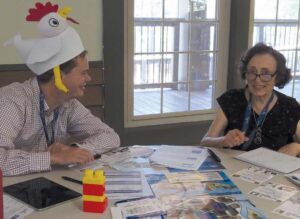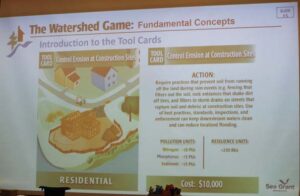We live on the water dominated planet. Planet Earth is 71 percent water and 29 percent land. When NASA scientists look for life on other planets, they look first for liquid water, the stuff of life as we know it.
Human activity has changed the quality of water on Earth. Educating and encouraging younger generations to draft plans and procedures and to suggest best practices to reduce water pollution is the aim of the Watershed Game—Classroom Version designed for middle and high school students. Minnesota Sea Grant and the University of Minnesota Extension designed the Watershed Game.
On June 26, Midlands educators convened at Clemson Sandhill REC Lake House for a professional development workshop to play The Watershed Game in teams. Trainers included E.V. Bell, education and outreach manager for the S.C. Sea Grant Consortium; Susan Lunt, water resources extension associate and Carolina Clear coordinator at Clemson University; Morgan Theon, president of the S.C. Marine Educators
Association; and Elle Pestorius, education graduate assistant at S.C. Sea Grant Consortium. The Environmental Education Association of S.C. provided lunch.
Teams worked at separate tables with a Coastal Model gameboard. The object of the team-building simulation is for each group to use limited financial resources to reduce non-point source pollutants to levels that meet their clean water goals. Nonpoint pollution includes fertilizer, pesticides, herbicides from farms and residential areas; oil, grease, and toxic chemicals from urban run-off; salt from roadways and fertilizer; acid drainage from mines; bacteria and waste from livestock, pet waste, and faulty septic systems; and atmospheric deposition. We know these pollutants have harmful effects on drinking water, recreational water, fisheries, and wildlife.
The Watershed Game has a Local Leader version for elected and appointed government officials, watershed organizations, riverkeepers, neighborhood associations, and other community leaders. The game helps communities be proactive rather than reactive in more frequent flood events attributed to climate change. Both the Classroom and Local Leader versions are valuable educational tools for teaching about the connection between land use and water quality, for practicing collaborative and cooperation decision-making, practicing leadership skills in resolving land and water use problems, and for drafting reasoned solutions and policies to protect and improve the quality of water resources.
The Clean Water Act of 1972 established the basic structure for regulating discharges of pollutants into the waters of the United States and regulating quality standards for surface waters. The Clean Water Act is a federal law enforced by the Environmental Protection Agency (EPA). The South Carolina Department of Environmental Services works with the EPA to administer and enforce the acts regulations related to water quality including efforts to address nonpoint source pollution.
The Watershed Game website has more details on each version, training videos, and purchase options: seagrant.umn.edu/watershed-game.
The South Carolina Sea Grant Consortium has a loaner program for the coast and stream classroom versions free-of-charge to any South Carolina K-12, informal, and homeschool educator. Visit the request form at www.scseagrant.org/watershed-game-loner-program/.





Loading Comments